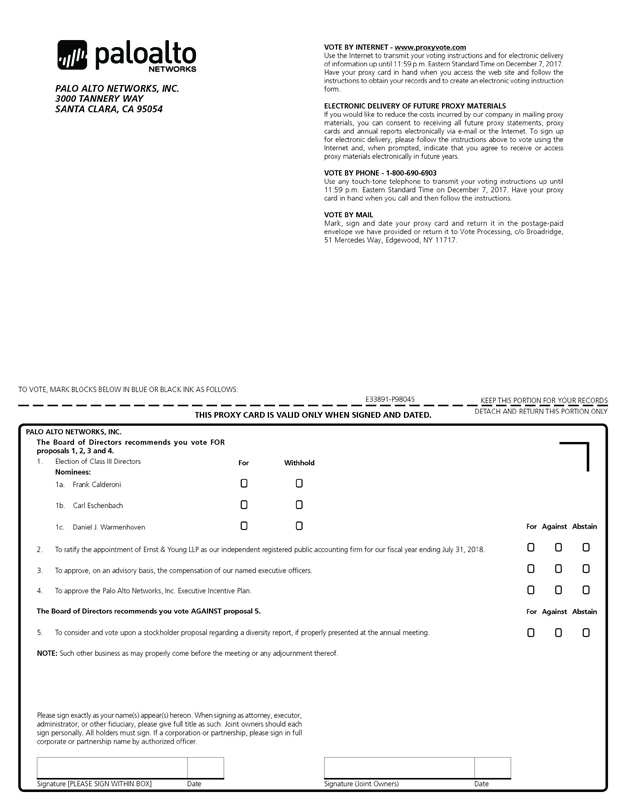UNITED STATES
SECURITIES AND EXCHANGE COMMISSION
Washington, D.C. 20549
SCHEDULE 14A
PROXY STATEMENT PURSUANT TO SECTIONProxy Statement Pursuant to Section 14(a) OF THE
SECURITIES EXCHANGE ACT OFof the
Securities Exchange Act of 1934
Filed by the Registrant ☒ Filed by a Party other than the Registrant ☐
Check the appropriate box:
(Amendment No. )
| ☑ | Filed by the Registrant | ☐ | Filed by a party other than the Registrant |
| CHECK THE APPROPRIATE BOX: | ||||
| ☐ | Preliminary Proxy Statement | |||
| ☐ | ||||
| Confidential, for Use of the Commission Only (as permitted byRule 14a-6(e)(2)) | ||||
| ☑ | ||||
| Definitive Proxy Statement | ||||
| ☐ | Definitive Additional Materials | |||
| ☐ | ||||
| Soliciting Material under | ||||
PALO ALTO NETWORKS, INC.
Palo Alto Networks Inc.
(Name of Registrant as Specified In Its Charter)
Payment
(Name of Person(s) Filing Fee (CheckProxy Statement, if other than the appropriate box):Registrant)
| PAYMENT OF FILING FEE (CHECK ALL BOXES THAT APPLY): | ||||||
| No fee | ||||||
| required | ||||||
| ☐ | ||||||
| ||||||
| ||||||
| ||||||
| ||||||
| ||||||
| Fee paid previously with preliminary | ||||||
| materials | ||||||
| ☐ | ||||||
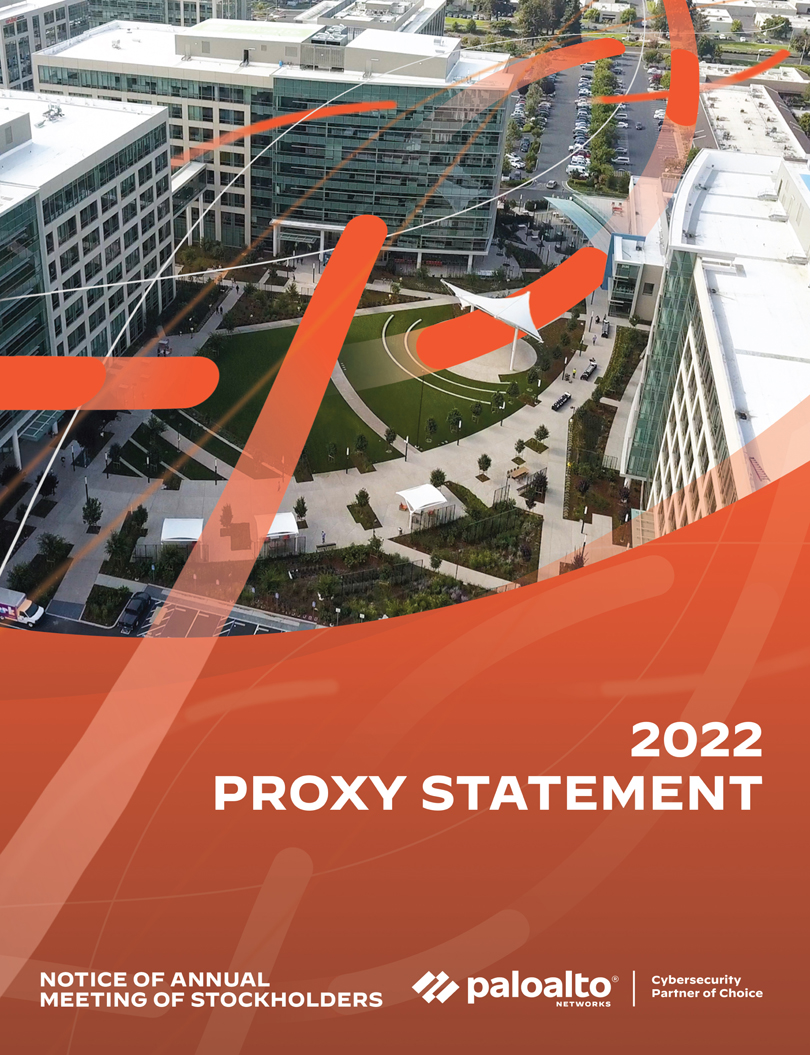

WHAT WE DO | OUR VISION | |
We innovate to stay ahead of the Whether deploying our products to enable the Zero Trust Enterprise, responding to a security incident, or partnering to deliver better security outcomes through a world-class partner ecosystem, we're committed to helping ensure each day is | Our vision is a world where each day is safer and |
Letter from the | |
 At Palo Alto Networks, we are rebuilding cybersecurity based on the principles of | ||||
Zero Trust, fueled by rigorous analytics and automation. We are here to secure the way forward by making cyber security stronger yet simpler so that each day is safer than the one before. We’ve Got Next and so will you.  |
| |||
| ||||
| ||||
 | ||||
Dear Fellow Stockholders:
Fiscal 2022 was another year of achievement at Palo Alto Networks. Our billings exceeded $7.4 billion, reflecting a growth rate of 37% year over year, and our revenues exceeded $5.5 billion – 29% year-over-year growth. In July, we celebrated our 10th anniversary as a public company. At the close of trading on the day of our initial public offering, our market capitalization was $3.5 billion, reflecting the value of a company that pioneered a new era of security through its groundbreaking firewall technology. Today, as our market capitalization exceeds $51 billion (at the close of trading on October 28, 2022), we are confident in the strong foundation we have built and eager to tackle the challenges of the next ten years.
As always, innovation drives our success. During the past year, we deployed 49 major product releases as compared to 29 in fiscal 2021, including advancements in next generation cloud access security broker (CASB), cloud code security, cloud next generation firewall and, in an industry first, agent and agentless cloud security posture management (CSPM) – just to name a few. We deliver to our customers best-of-breed capabilities across a platform of network security, cloud security and security operations. Simply put, we remain the cybersecurity leader, serving tens of thousands of customers worldwide, many of whom are still in the early stages of their cybersecurity transformations.
Finally, we recognize the contributions and character of Mark McLaughlin and Asheem Chandna, neither of whom will stand for reelection to the Board of Directors when their terms expire at the conclusion of our 2022 Annual Meeting of Stockholders. Mark’s leadership as the company’s chief executive officer from August 2011 until June 2018, and his continued service on our Board of Directors since then, have been instrumental in driving the company’s growth and nurturing our unique culture. Likewise, without Asheem’s technical expertise, financial acumen and, most notably, keen discernment of emerging technology trends, our transformation into the company we are today would have been less complete and consequential. On behalf of our employees and the entire Board of Directors, we express our deep appreciation to Mark and Asheem for their profound impacts on Palo Alto Networks.
* * * * *
As in the past, this year’s Proxy Statement is constructed to maximize clarity and understanding about the company’s strategies, successes and challenges. Several of our key initiatives are worth prefacing here.
Stockholder Engagement. We remain guided by, and appreciative of, the perspectives of our stockholders as expressed through their engagement with us. Throughout fiscal 2022, we once again executed an extensive stockholder outreach program. In total, we engaged in discussions with stockholders holding approximately 60% of our outstanding shares as of June 30, 2022. John, as our Lead Independent Director, remained at the forefront of our engagement efforts and participated in 30 meetings with stockholders holding approximately 39% of our outstanding shares as of June 30, 2022. In addition to our financial outlook, our stockholders conversed with us about our executive compensation, sustainability, corporate governance practices, inclusion and diversity, as well as other topics of import to them. We will continue this valuable dialogue with our investors in the coming year, and are committed to maintaining outreach that is truly a dialogue with our stockholders.
| 2022 Proxy Statement | 3 |
PALO ALTO NETWORKS, INC.
Letter from the Chair and the Lead Independent Director
Executive Compensation. We implemented the commitments that we made to our stockholders in our 2021 proxy statement. We maintained an executive compensation program closely tied to our financial performance, 100% of our named executive officers’ equity compensation awards (aside from new hire awards) were performance-based, with different performance targets than the cash incentive plan awards, added an ESG modifier to our cash incentive plan, increased the stock ownership guidelines for our executive officers, and established a one-year equity post vesting holding period for all named executive officers. The compensation discussion and analysis (CD&A) section of this Proxy Statement describes our performance against these commitments. We encourage you to read the letter from our Compensation and People Committee accompanying the CD&A for their views on our executive compensation program, particularly as it relates to our pay-for-performance philosophy and how we performed against that backdrop.
3000 TANNERY WAYOur Commitment to ESG. We continue to take seriously our commitment to environmental sustainability, social responsibility and corporate governance (ESG). In fiscal 2022, in direct response to the feedback we received from our stockholders, your Board of Directors adopted majority voting for uncontested elections of directors and a resignation policy in the event a director does not receive a majority of the vote. Elsewhere in Proxy Statement, we discuss our ESG successes in fiscal 2022 and provide an overview of our ESG programs and commitments, and how your Board and executive leadership team oversee our ESG efforts.
SANTA CLARA, CALIFORNIA 95054
NOTICE OF ANNUAL MEETING OF STOCKHOLDERS
To Be Held at 10:00 a.m. Pacific Standard Time on Friday, December 8, 2017
DearYou are cordially invited to attend the 2022 Annual Meeting of Stockholders of Palo Alto Networks, Inc.: to be held on Tuesday, December 13, 2022 at 12:15 P.M., Pacific Time.
The 2017This year’s annual meeting will be a virtual meeting conducted via a live webcast. You will be able to listen to the annual meeting, submit your questions, and vote during the live webcast of stockholdersthe meeting by visiting www.virtualshareholdermeeting.com/PANW2022 and any postponements, adjournmentsentering the 16-digit control number included on your proxy card or continuations thereof (the “Annual Meeting”)in the instructions that accompanied your proxy materials. If you did not receive a 16-digit control number, please reach out to your broker for further instructions.
On behalf of our Board, we thank you for your investment in Palo Alto Networks Inc., a Delaware corporation, will be heldand for your continued trust. We look forward to the annual meeting onFriday, December 8, 2017 at 10:00 a.m. Pacific Standard Time, at our headquarters, located at 3000 Tannery Way, Santa Clara, California 95054, for the following purposes, as more fully described in the accompanying proxy statement: 13, 2022.
Thank you,
 |  | |
| Nikesh Arora | John M. Donovan | |
| Chair and | Lead Independent | |
| Chief Executive Officer | Director |
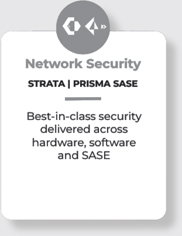


| 4 |  |
 Palo Alto Networks, Inc. Palo Alto Networks, Inc. | |
 |  |  | ||
| DATE AND TIME | VIRTUAL MEETING SITE | WHO CAN VOTE | ||
| Tuesday, December 13, 2022 12:15 PM Pacific Time | www.virtualshareholdermeeting.com/ | Stockholders of record as of October 14, 2022 are entitled to vote |
Voting Items
| Proposals | Board Vote Recommendation | For Further Details | ||
| 1. | To elect |  | “FOR” each director nominee | Page 40 |
| 2. | To ratify the appointment of Ernst & Young LLP as our independent registered public accounting firm for our fiscal year ending July 31, |  | “FOR” | Page 57 |
| 3. | To approve, on an advisory basis, the compensation of our named executive |  | “FOR” | Page 60 |
| 4. | To approve an amendment to the 2021 Palo Alto Networks, Inc. |  | “FOR” | Page 98 |
Our board of directors has fixed the close of business on October 16, 2017 as the record date for the Annual Meeting. Only stockholders of record on October 16, 2017 are entitled to notice of and to vote at the Annual Meeting. Further information regarding voting rights and the matters to be voted upon is presented in the accompanying proxy statement.Meeting or any adjournments or postponements thereof.
On or about October 23, 2017, we expect to mail to our stockholders a Notice of Internet Availability of Proxy Materials (the “Notice”) containing instructions on how to access our proxy statement and our annual report. The Notice provides instructions on how to vote via the Internet or by telephone and includes instructions on how to receive a paper copy of our proxy materials by mail. The accompanying proxy statement and our annual report can be accessed directly at the following Internet address: http://www.proxyvote.com. All you have to do is enter the control number located on your proxy card.
YOUR VOTE IS IMPORTANT. Whether or notPlease act as soon as possible to vote your shares, even if you plan to attend the Annual Meeting, we urge youannual meeting online. For instructions to submit your vote via the Internet, telephone or mail as soon as possible to ensure your shares are represented.and more information, see “About the Annual Meeting” on page 112.
We appreciate your continued support of Palo Alto Networks Inc. and look forward to either greeting you personally at the Annual Meeting or receiving your proxy.
By orderOrder of the Board of Directors,
Bruce Byrd
Executive Vice President, General Counsel and Corporate Secretary
November 3, 2022
HOW TO VOTE
| ONLINE | BY PHONE | BY MAIL |
| Visit www.proxyvote.com. prior to the Annual Meeting, 24 hours a day, seven days a week. | Call the phone number located on the accompanying proxy card or voting instruction form. | Complete, sign, date and return the accompanying proxy card or voting instruction form in the envelope provided. |
IMPORTANT NOTICE REGARDING THE AVAILABILITY OF PROXY MATERIALS FOR THE ANNUAL MEETING TO BE HELD ON DECEMBER 13, 2022: THE NOTICE OF 2022 ANNUAL STOCKHOLDERS’ MEETING AND PROXY STATEMENT AND THE 2022 ANNUAL REPORT ON FORM 10-K ARE AVAILABLE AT WWW.PROXYVOTE.COM.
| 2022 Proxy Statement | 5 |
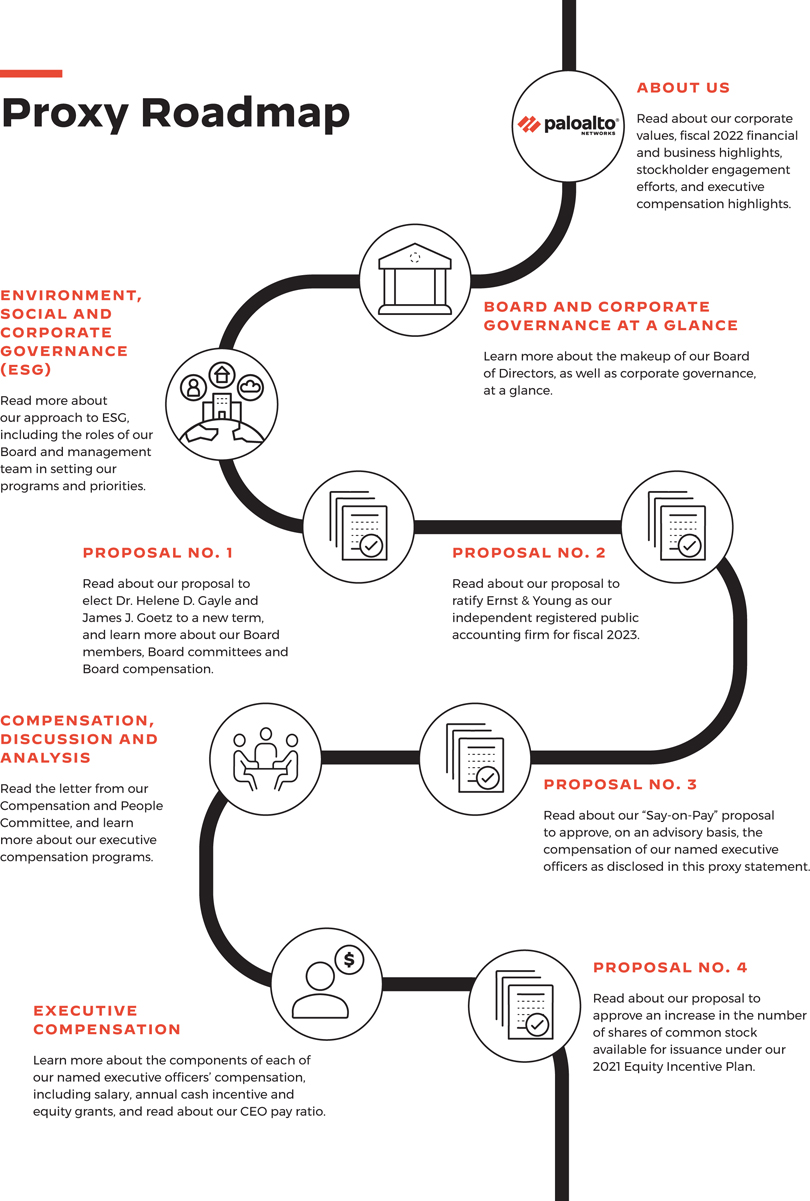
| 6 |  |

Mark McLaughlin
Chairman and Chief Executive Officer
Santa Clara, California
October 23, 2017
Table of ContentsTABLE OF CONTENTS
Our Company Palo Alto Networks is a global cybersecurity provider with a vision of a world where each day is safer and more secure than the one before. We were incorporated in Delaware in 2005 and are headquartered in Santa Clara, California. Our principal executive offices are located at 3000 Tannery Way, Santa Clara, CA 95054. We empower enterprises, organizations, service providers, and government entities to protect themselves against today’s most sophisticated cyber threats. Our cybersecurity platforms and services help secure enterprise users, networks, clouds, and endpoints by delivering comprehensive cybersecurity backed by industry leading artificial intelligence and automation. We are a leading provider of zero trust solutions, starting with next-generation zero trust network access to secure today’s remote hybrid workforces and extending to securing all users, applications and infrastructure with zero trust principles. Our security solutions are designed to reduce customers’ total cost of ownership by improving operational efficiency and eliminating the need for siloed point products. Our Company focuses on delivering value in five fundamental areas: Network Security, Secure Access Service Edge, Cloud Security, Security Operations, and Threat Intelligence and Security Consulting. | |
Our corporate decisions are guided by our corporate values, which were co-created by our employees. Foremost among these is integrity, which is the foundation of everything we do and every decision we make. We believe that collaboration enhances our ability to disrupt entrenched beliefs, which we think ultimately leads to innovation. Our ability to execute on our innovations and deliver products and services that address the cybersecurity needs of our customers is critical to our long-term success. Finally, we are intentional about including diverse points of view, perspectives, experiences, backgrounds and ideas in our decision-making process. True inclusion and diversity exists when we have representation of all ethnicities, orientations and identities, and cultures in our workforce. We believe that our core values make us a better company. | |||||||
| |||||||
| |||||||
| |||||||
| |||||||
| |||||||
| |||||||
| |||||||
| |||||||
| |||||||
| |||||||
 | ||||
 |  |  |  | |
| “...Palo Alto is #10 in our list of the 50 best companies to work for women; list created from millions of anonymous employer ratings and reviews by working women” | “...for the third consecutive year, received a perfect score on the Human Rights Campaign Foundation’s 2021 Corporate Equality Index (CEI) and achieved designation as a Best Place to Work for LGBTQ Equality” | “...Palo Alto Networks in the top 10% of companies on Comparably in its diversity score, [which] provides insights into how diverse employees feel and rate their work experience across various culture dimensions” | “...the companies that made this list are delivering the respect, care, and appreciation that it takes to create a positive workplace that nurtures talent [.]” Newsweek recognized PANW in the top 100 most loved workplaces of the Year | |
| Sept. 2021 (InHerSight) | Jan. 2022 (Human Rights Campaign Foundation) | Sept. 2021 (Comparably) | Oct. 2021 (Newsweek) |
| 2022 Proxy Statement | 7 |
About Us
We delivered another year of outstanding results for our stockholders in fiscal 2022, with a strong year of financial performance and execution. Highlights include: | |
•Total revenue increased to $5.5 billion, or by approximately 29% compared to fiscal 2021. •Total billings increased to $7.5 billion, or by approximately 37% compared to fiscal 2021.1 •Next-Gen Security ARR increased to $1.89 billion, or by approximately 60% compared to fiscal 2021.2 • In the fourth quarter of fiscal 2022, we achieved GAAP profitability. • Continued to return capital to our stockholders through our stock repurchase program, totaling $0.9 billion for fiscal 2022, for a total of $3.6 billion during fiscal 2019 through fiscal 2022. •Accelerated our product innovation efforts, with 49 major product releases.3 | |
Building a Stronger
Palo Alto Networks
| TOTAL REVENUE ($ in millions) | TOTAL BILLINGS ($ in millions) | |
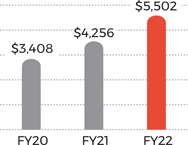 |  | |
NEXT-GEN
| PRODUCT INNOVATION Major Product Releases | |
 | ||
 Security Operations Security Operations | ||
 Cloud Security Cloud Security | ||
 Network Security Network Security |
| RETURN OF CAPITAL | |
| Fiscal 2022 | Fiscal 2019-2022 |
| $0.9 Billion | $3.6 Billion |
| 1. | Total billings is a key financial metric calculated as total revenue plus change in total deferred revenue, net of total acquired deferred revenue. Appendix A includes a calculation of total billings. |
| 2. | Next-Gen Security ARR is annualized allocated revenue of all active contracts as of the final day of the reporting period for Prisma and Cortex offerings inclusive of the VM-Series and related services, and certain cloud-delivered security services. |
| 3. | Major product release is defined as full or dot release with significant new capability, new or add-on modules, or subscription services, new software or hardware appliance models, significant PAN-OS, acquired capabilities and significant new platform support. |
| 8 |  |
About Us
Stockholder Engagement
We are proud of our investor engagement program, and committed to maintaining outreach that is truly a dialogue with our stockholders. Our relationship with our stockholders is an important part of our Company’s success. In fiscal 2022, we once again engaged in robust stockholder engagement, with a focus on executive compensation, environmental sustainability, social responsibility, and corporate governance (ESG), and other matters of particular import to our stockholders. Our Lead Independent Director played a central role in developing and implementing our program, and once again actively participated in our stockholder engagement efforts in fiscal 2022.
Our Lead Independent Director and management team regularly update our Board and Board committees on our engagement efforts, providing summaries and analyses of our stockholders’ feedback. The feedback that we received from our stockholders resulted in significant improvement in our compensation and corporate governance practices, as described in detail in this proxy statement, including our adoption of majority voting for uncontested elections of our directors in May 2022.
We believe that our approach to engaging directly and openly with our investors drives increased corporate accountability, improves decision making, and ultimately creates long-term value.
 |  |  |
| We engaged in discussions with investors representing 60% of our outstanding shares (which is all stockholders that indicated a willingness to engage with us). | Our Lead Independent Director participated in discussions (30 meetings) with investors representing 39% of our outstanding shares. |
| * Stockholder ownership, to our knowledge, as of June 30, 2022. | ||
Below are the key elements of our stockholder engagement cycle:
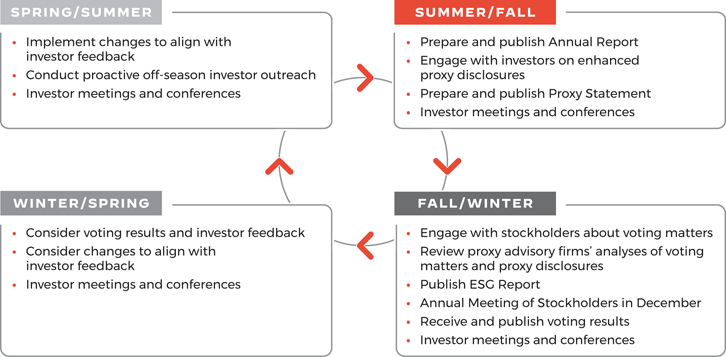
| 9 |
About Us
Executive Compensation
Our Compensation Best Practices
In fiscal 2022, we implemented our redesigned executive compensation programs, meeting the commitments we made to our stockholders in our 2021 proxy statement. Our compensation programs reflect recognized best practices and principles that align the compensation of our named executive officers with the long-term interests of our stockholders, and are supported by market benchmarks.
 100% of equity compensation (aside from new hire awards) is performance-based, with different performance targets than the cash incentive plan 100% of equity compensation (aside from new hire awards) is performance-based, with different performance targets than the cash incentive plan Addition of ESG modifier to cash incentive plan, which modifies the annual incentive cash compensation (plus or minus 10%), based on our performance relative to an ESG scorecard with climate, inclusion and Addition of ESG modifier to cash incentive plan, which modifies the annual incentive cash compensation (plus or minus 10%), based on our performance relative to an ESG scorecard with climate, inclusion and |  Increase to stock ownership guidelines Increase to stock ownership guidelines One-year post-vesting holding period for all NEOs, including our Chief Executive Officer One-year post-vesting holding period for all NEOs, including our Chief Executive Officer |
| ||
 100% independent Compensation and 100% independent Compensation and  Independent compensation consultants Independent compensation consultants |  Annual review of compensation strategy Annual review of compensation strategy Consideration of annual say-on-pay vote Consideration of annual say-on-pay vote |
 Majority of compensation is performance-based and at-risk Majority of compensation is performance-based and at-risk 100% of fiscal 2022 equity compensation for NEOs performance-based and at risk (excluding new hire grants) 100% of fiscal 2022 equity compensation for NEOs performance-based and at risk (excluding new hire grants) 100% of short-term incentive cash compensation is performance-based and at-risk 100% of short-term incentive cash compensation is performance-based and at-risk No single trigger vesting of equity awards on occurrence of a change in control No single trigger vesting of equity awards on occurrence of a change in control No dividends paid on unvested equity No dividends paid on unvested equity Robust stock ownership guidelines Robust stock ownership guidelines |  No hedging or pledging, except limited pledging permitted with the prior approval of the No hedging or pledging, except limited pledging permitted with the prior approval of the  Meaningful clawback policy Meaningful clawback policy Limited perquisites and personal benefits Limited perquisites and personal benefits No defined benefit plans or SERPs No defined benefit plans or SERPs Implementing the advice of independent compensation consultants Implementing the advice of independent compensation consultants |
| 10 |  |
About Us
Significant At-Risk Compensation
Our executive compensation program is tied to our financial and operational performance. The graphs below illustrate the predominance of at-risk and performance-based components of our fiscal 2022 compensation program for our Chief Executive Officer and other named executive officers.
CEO | AVERAGE OF OTHER NEOs(2) |
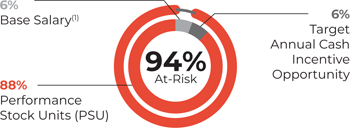 | 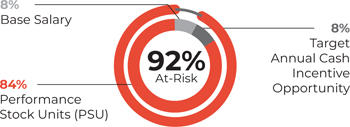 |
| (1) | Graph reflects Mr. Arora’s target base salary of $1 million, a significant portion of which he elected to forgo. |
| (2) | Excludes Mr. Jenkins’ new hire RSUs which were granted to compensate him for a portion of our estimated value of the unvested equity that he forfeited upon joining us. |
| 2022 Proxy Statement | 11 |
This page intentionally left blank.
| |
PROXY STATEMENT
FOR 2017 ANNUAL MEETING OF STOCKHOLDERS
To Be Held at 10:00 a.m. Pacific Standard Time on Friday, December 8, 2017
This proxy statementdocument includes forward-looking statements within the meaning of the Private Securities Litigation Reform Act of 1995. All statements other than statements of historical or current facts, including statements regarding our social, environmental and your proxy cardsustainability plans and goals, and executive compensation plans, made in this document are furnishedforward-looking. We use words such as anticipates, plan, believes, expects, future, intends, and similar expressions to identify forward-looking statements. Forward-looking statements reflect management’s current expectations and are inherently uncertain. Actual results could differ materially for a variety of reasons. Risks and uncertainties that could cause our actual results to differ significantly from management’s expectations are described in connection with the solicitation of proxies by our board of directors for use2022 Annual Report on Form 10-K. Unless otherwise provided herein, all statements in connection with the 2017 annual meeting of stockholders of Palo Alto Networks, Inc. (“Palo Alto Networks”), a Delaware corporation, and any postponements, adjournments or continuations thereof (the “Annual Meeting”). The Annual Meeting will be held on Friday, December 8, 2017 at 10:00 a.m. Pacific Standard Time, at our headquarters, located at 3000 Tannery Way, Santa Clara, California 95054. A Notice of Internet Availability of Proxy Materials (the “Notice”) containing instructions on how to access this proxy statement are as of November 3, 2022.
References to our website in this proxy statement are not intended to function as a hyperlink and our annual report is first being mailed on or about October 23, 2017 to all stockholders entitled to vote at the Annual Meeting. Informationinformation contained on or that can be accessed through, our website is not intended to be part of this proxy statement.
In this proxy statement, the terms “the Company”, “we,” and “our” refer to Palo Alto Network, Inc. and the term “Board” refers to the Board of Directors of Palo Alto Networks, Inc.
To the extent that this proxy statement has been or will be specifically incorporated by reference into this proxy statement and references to our website address in this proxy statement are inactive textual references only.
The information provided in the “question and answer” format below is for your convenience only and is merely a summaryany other filing of the information contained in this proxy statement. You should read this entire proxy statement carefully.
What matters am I voting on?
You will be voting on:
How does the board of directors recommend I vote on these proposals?
Our board of directors recommends a vote:
Who is entitled to vote?
Holders of our common stock as of the close of business on October 16, 2017 (the “Record Date”), may vote at the Annual Meeting. As of the Record Date, 91,977,343 shares of our common stock were outstanding. In
- 1 -
deciding all matters at the Annual Meeting, each stockholder will be entitled to one vote for each share of our common stock held by them on the Record Date. Stockholders may not cumulate votes in the election of directors.
Registered Stockholders. If shares of our common stock are registered directly in your name with our transfer agent, you are considered the stockholder of record with respect to those shares, and the Notice was provided to you directly by us. As the stockholder of record, you have the right to grant your voting proxy directly to the individuals listed on the proxy card or to vote in person at the Annual Meeting. Throughout this proxy statement, we refer to these registered stockholders as “stockholders of record.”
Street Name Stockholders. If shares of our common stock are held on your behalf in a brokerage account or by a bank or other nominee, you are considered to be the beneficial owner of shares that are held in “street name,” and the Notice was forwarded to you by your broker, bank or other nominee, who is considered the stockholder of record with respect to those shares. As the beneficial owner, you have the right to direct your broker, bank or other nominee as to how to vote your shares. Beneficial owners are also invited to attend the Annual Meeting. However, since a beneficial owner is not the stockholder of record, you may not vote your shares in person at the Annual Meeting unless you follow your broker, bank, or other nominee’s procedures for obtaining a legal proxy and present your legal proxy at the Annual Meeting. If you request a printed copy of our proxy materials by mail, your broker, bank or other nominee will provide a voting instruction form for you to use. Throughout this proxy statement, we refer to stockholders who hold their shares through a broker, bank or other nominee as “street name stockholders.”
Can I attend the Annual Meeting?
How do I vote?
If you are a stockholder of record, there are four ways to vote:
- 2 -
Even if you plan to attend the Annual Meeting, we recommend that you also vote by proxy so that your vote will be counted if you later decide not to attend the Annual Meeting.
If you are a street name stockholder, you will receive voting instructions from your broker, bank or other nominee. You must follow the voting instructions provided by your broker, bank or other nominee in order to direct your broker, bank or other nominee on how to vote your shares. Street name stockholders should generally be able to vote by returning a voting instruction form, or by telephone or on the Internet. However, the availability of telephone and Internet voting will depend on the voting process of your broker, bank or other nominee. As discussed above, if you are a street name stockholder, you may not vote your shares live at the Annual Meeting unless you obtain a legal proxy from your broker, bank or other nominee.
Can I change my vote?
Yes. If you are a stockholder of record, you can change your vote or revoke your proxy any time before the Annual Meeting by:
If you are a street name stockholder, your broker, bank or other nominee can provide you with instructions on how to change your vote or revoke your proxy.
What is the effect of giving a proxy?
Proxies are solicited by and on behalf of our board of directors. The persons named in the proxy have been designated as proxies by our board of directors. When a proxy card is properly dated, executed and returned, the shares represented by such proxies will be voted at the Annual Meeting in accordance with the instruction of the stockholder. If a proxy card is signed, but no specific instructions are given, the shares represented by such proxy card will be voted in accordance with the recommendations of our board of directors, as described above. If any matters not described in this proxy statement are properly presented at the Annual Meeting, the proxy holders will use their own judgment to determine how to vote the shares subject to proxies. If the Annual Meeting is adjourned, the proxy holders can vote your shares subject to proxies when the Annual Meeting is rescheduled, unless you have properly revoked your proxy instructions, as described above.
Why did I receive the Notice instead of a full set of proxy materials?
In accordance with the rules ofCompany under the Securities and Exchange Commission (“SEC”), we have elected to furnish our proxy materials, including this proxy statement and our annual report, primarily via the Internet. The Notice containing instructions on how to access our proxy materials is first being mailed onAct of 1933, as amended, or about October 23, 2017 to all stockholders entitled to vote at the Annual Meeting. Stockholders may request to receive all future proxy materials in printed form by mail or electronically bye-mail by following the instructions contained in the Notice. We encourage stockholders to take advantage of the availability of our proxy materials on the Internet to help reduce the environmental impact of our annual meetings of stockholders.
- 3 -
What is a quorum?
A quorum is the minimum number of shares required to be present for the Annual Meeting to be properly held under our amended and restated bylaws and Delaware law. The presence, in person or by proxy, of a majority of all issued and outstanding shares of our common stock entitled to vote at the Annual Meeting will constitute a quorum at the Annual Meeting. A proxy submitted by a stockholder may indicate that all or a portion of the shares represented by the proxy are not being voted (“stockholder withholding”) with respect to a particular matter. Similarly, a broker may not be permitted to vote shares held in street name on a particular matter in the absence of instructions from the beneficial owner of such shares (“brokernon-vote”). See the section titled “How may my broker, bank or other nominee vote my shares if I fail to timely provide voting instructions?” The shares of our common stock subject to a proxy that are not being voted on a particular matter because of either stockholder withholding or a brokernon-vote will count for purposes of determining the presence of a quorum. Abstentions are also counted in the determination of a quorum.
How many votes are needed for approval of each proposal?
|
- 4 -
|
How are proxies solicited for the Annual Meeting?
Our board of directors is soliciting proxies for use at the Annual Meeting. All expenses associated with this solicitation will be borne by us. We will reimburse brokers, banks or other nominees for reasonable expenses that they incur in sending our proxy materials to you if a broker, bank or other nominee holds your shares of our common stock. In addition to using the internet, our directors, officers and employees may solicit proxies in person and by mail, telephone, facsimile, or electronic transmission, for which they will not receive any additional compensation. We have retained Saratoga Proxy Consulting LLC to assist us in soliciting proxies for a fee of $15,000, plus reasonableout-of-pocket expenses incurred in the process of soliciting proxies.
How may my broker, bank or other nominee vote my shares if I fail to timely provide voting instructions?
Brokerage firms, banks or other nominees holding shares of our common stock in street name for beneficial owners are generally required to vote such shares in the manner directed by the beneficial owner. In the absence of timely directions, your broker, bank or other nominee will have discretion to vote your shares on our sole “routine” matter, the proposal to ratify the appointment of Ernst & Young LLP as our independent registered public accounting firm for our fiscal year ending January 31, 2018. Your broker will not have discretion to vote on any other proposals, which are“non-routine” matters, absent direction from you.
Is my vote confidential?
Proxy instructions, ballots, and voting tabulations that identify individual stockholders are handled in a manner that protects your voting privacy. Your vote will not be disclosed either within Palo Alto Networks or to third parties, except as necessary to meet applicable legal requirements, to allow for the tabulation of votes and certification of the vote, or to facilitate a successful proxy solicitation. Occasionally, stockholders provide written comments on their proxy cards, which may be forwarded to management and our board of directors.
Where can I find the voting results of the Annual Meeting?
We will announce preliminary voting results at the Annual Meeting. We will also disclose voting results on a Current Report on Form8-K that we will file with the SEC within four business days after the Annual Meeting. If final voting results are not available to us in time to file a Current Report on Form8-K within four business days after the Annual Meeting, we will file a Current Report on Form8-K to publish preliminary voting results and will provide the final voting results in an amendment to the Current Report on Form8-K as soon as they become available.
I share an address with another stockholder, and we received only one paper copy of the proxy materials. How may I obtain an additional copy of the proxy materials?
We have adopted a procedure called “householding,” which the SEC has approved. Under this procedure, we deliver a single copy of the Notice, and if applicable, our proxy materials, to multiple stockholders who share the same address unless we receive contrary instructions from one or more of the stockholders sharing the same address. This procedure reduces our printing costs, mailing costs, and fees. Stockholders who participate in householding will continue to be able to access and receive separate copies of the Notice, or if applicable, our proxy materials. Upon written or oral request, we will deliver promptly separate copies of the Notice and, if applicable, our proxy materials, to any stockholder at a shared address which we delivered a single copy of any of these materials. To receive a separate copy, or, if a stockholder is receiving multiple copies, to request that we only send a single copy of the Notice or, if applicable, our proxy materials, stockholders may contact us at the following: Palo Alto Networks, Inc., Attention: Investor Relations, 3000 Tannery Way, Santa Clara, California 95054 or Tel: (408)753-4000.
- 5 -
Stockholders who hold shares of our common stock in street name may contact their brokerage firm, bank, broker-dealer or other similar organization to request information about householding.
What is the deadline to propose actions for consideration at next year’s annual meeting of stockholders or to nominate individuals to serve as directors?
Stockholder Proposals
Stockholders may present proper proposals for inclusion in our proxy statement and for consideration at the next annual meeting of stockholders by submitting their proposals in writing to our Corporate Secretary in a timely manner. For a stockholder proposal to be considered for inclusion in our proxy statement for our 2018 annual meeting of stockholders, our Corporate Secretary must receive the written proposal at our principal executive offices not later than June 25, 2018. In addition, stockholder proposals must comply with the requirements ofRule 14a-8 under the Securities Exchange Act of 1934, as amended, (the “Exchange Act”the sections of this proxy statement titled “Report of the Audit Committee” and “Report of the Compensation Committee” shall not be deemed to be so incorporated, unless specifically stated otherwise in such filing.
| 2022 Proxy Statement | 13 |
Our Board consists of a diverse group of highly qualified leaders in their respective fields who bring unique perspectives to the Board. All directors have either held senior leadership positions at large companies or otherwise gained significant and wide-ranging management experience in their respective fields (including strategic, financial, public company financial reporting, compliance, risk management, and leadership development). Many of our directors also have public company experience (serving as chief executive officer, chief operating officer, or chief financial officer, or on boards of directors and board committees), and as a result have a deep understanding of corporate governance practices, including risk and management oversight.

| 14 |  |
Our Board at a Glance

| 2022 Proxy Statement | 15 |
Our Corporate Governance at a Glance

| º | Appointed four new directors since 2019, including three who brought gender, ethnic and/or racial diversity to the Board |
| º | culture, employee retention and human capital management (Compensation and People Committee oversight) |
| º | sustainability and corporate governance (ESG and Nominating Committee) | |
| º | security and cybersecurity (Security Committee) |
| º | financial reporting, internal controls over financial reporting, and enterprise risk relating to financial matters (Audit Committee) |
| º | M&A and strategic transactions (Corporate Development Committee) |
| º | In response to stockholder feedback, adopted majority voting for uncontested elections of directors, including a resignation policy in the event a director does not receive a majority of the vote |
| 16 |  |
An Overview of Our ESG Strategies
Our values of execution, disruption, collaboration, inclusion and integrity are the foundation of everything we do—which extend into our approach to environmental, social and corporate governance (“ESG”) practices. From our climate commitments, our people strategy based on FLEXWORK, and our supplier responsibility initiatives, to our social impact programs and our dedication to integrity, ethics, security and privacy, we believe we are executing meaningful outcomes that reinforce our intention to respect our planet, uplift our communities and advance our industry. The content that follows summarizes the actions we have taken, the impact we believe we have had and our ongoing journey to demonstrate leadership in ESG.
ESG at Palo Alto Networks is overseen and governed at the highest levels and includes Board and committee oversight, executive-level leadership, and subject-matter experts who lead our ESG efforts across our business.
Board Oversight. The Board and its applicable committees provide guidance and oversight to management with respect to ESG matters. During fiscal 2022, we reconstituted our Nominating and Corporate Governance Committee as the ESG and Nominating Committee to enhance the Board’s oversight of ESG matters and reinforce the important role that ESG practices play in our business. The ESG and Nominating Committee is responsible for setting our ESG priorities and monitoring our performance. Our Compensation and People Committee, Audit Committee and Security Committee also serve an important role in ESG oversight. Our Lead Independent Director and management team share feedback received from our stockholders with the Board.
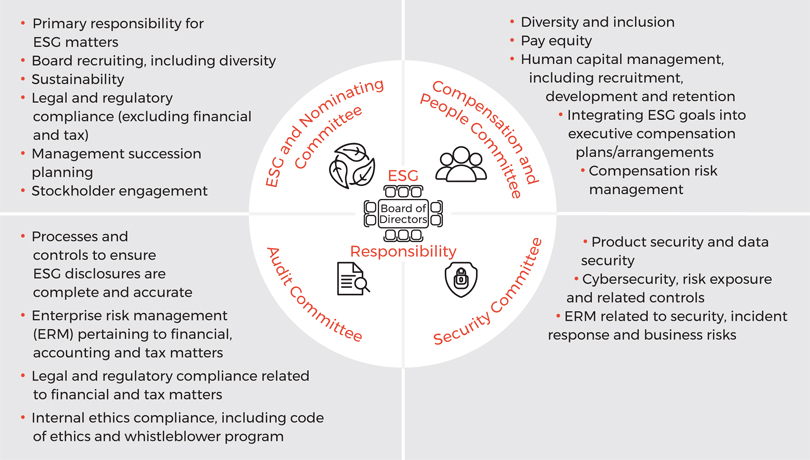
| 2022 Proxy Statement | 17 |
ESG at Palo Alto Networks
Management Leadership.A cross-functional, executive-level ESG leadership team sets our overall ESG strategy, objectives and initiatives, provides guidance on program implementation, and oversees the continuing enhancement of our approach to ESG. This committee which is led by our Chief Executive Officer and includes our General Counsel, Chief People Officer and Chief Financial Officer, receives analysis and presentations regarding current and emerging ESG-related risk topics and the status of our ESG programs.
Our executive-level ESG leadership team also empowers our ESG steering committee to implement our ESG programs and to pursue activities to achieve our objective and goals. The ESG steering committee is a cross functional team of employees, consisting of representatives from our accounting, internal audit, corporate responsibility, legal, investor relations and operations teams, and oversees the work of our subject matter experts in the implementation of our ESG programs.
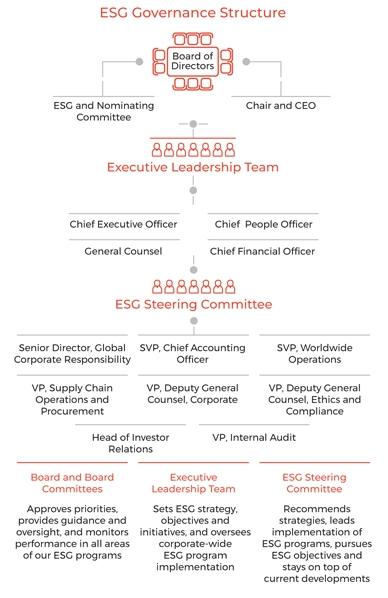 |
| 18 |  |
ESG at Palo Alto Networks
Climate change is a global crisis and we are committed to doing our part to reduce our environmental impacts. Aligned to the Climate Commitments we declared in early 2021, in fiscal 2022 we evolved our comprehensive Sustainability Strategy focused on three pillars: operational excellence (Sustainable Operations), a Sustainable Value Chain, and a Sustainable Ecosystem. In fiscal 2022, we engaged with external consultancies, conducted a comprehensive analysis of our global environmental footprint, and obtained third party assurance of our analysis and related emissions data, across all three pillars.
 | SUSTAINABLE OPERATIONS Accelerate carbon and waste free growth across our FLEXWORK footprint through energy efficiency, decarbonization, renewable energy and science-based targets. |
 | SUSTAINABLE VALUE CHAIN Collaborate and partner with stakeholders throughout our value chain to drive to zero carbon, zero waste, 100% renewable energy and 100% circular cybersecurity products. |
 | SUSTAINABLE ECOSYSTEM Drive leading public commitments, policy advocacy and partnerships to elevate our thought leadership position in sustainable cybersecurity. |
Raising Our Ambition
We raised the ambition of our Climate Commitments through developing and setting Science-Based Targets (“SBTs”) aligned to a climate scenario of 1.5° celsius. They are:
Palo Alto Networks commits to reduce Scope 1 and 2 GHG emissions by 35% by the end of fiscal 2027, as compared to fiscal 2021.
Palo Alto Networks commits to get 65% of our suppliers (measured by total spend) to set Science-Based Targets by the end of fiscal 2027.
Palo Alto Networks commits to reduce emissions from our customers’ use of our products by 40% by the end of fiscal 2027.
| 2022 Proxy Statement | 19 |
ESG at Palo Alto Networks
Our SBTs were submitted to the Science-Based Targets Initiative for verification, which we expect to obtain in 2023.
In fiscal 2022, in line with the most reputable non-governmental organizations (“NGOs”), we refined and elevated our Carbon Neutral goal to be defined as “Net Zero” targets:
Through our climate ambition across our operations, value chain and ecosystem, we are confident that we can achieve these goals by the dates above.
Sustainable Operations
Early in fiscal 2022, we elevated our operational goals by committing to purchasing 100% true renewable energy, expanding operational excellence through deep energy efficiency, and driving decarbonization throughout our real estate footprint.
We continued to execute our sustainable approach to real estate and opened new LEED certified offices in multiple cities, including London and Bangalore, and expanded our LEED footprint through certifications in Tel Aviv, Bangalore and San Francisco. We launched multiple sustainability work groups to evaluate and act on implementing green packaging, waste reduction and resource conservation. To address the digital divide, promote reuse and reduce our e-waste, we engaged in an external partnership to efficiently donate obsolete equipment, accessories and furnishings for social benefit.
| Sustainable Value Chain | |
| Through our carbon footprint assessment, we gained a complete understanding of where our greatest impacts - and best opportunities - are, and we set 1.5° Celsius aligned Science-Based Targets to effectively address them. We set critical Scope 1 and 2 SBTs, but we know that our greatest impact is in our Scope 3 emissions. Because of this, we have set what we believe are ambitious SBTs to drive a Sustainable Value Chain across our purchased goods and services and the use by our customers of the products we sell to them. |
Achieved a Supplier Engagement |
Throughout fiscal 2022, we began the journey to engage stakeholders throughout our value chain, from suppliers to customers, to drive to zero carbon, zero waste, 100% renewable energy and 100% circularity in our cybersecurity products.
| Sustainable Ecosystem | |
| Recognizing that addressing climate change will require collaboration on systemic issues, we increased and expanded our engagements with environmental coalitions. By joining The Climate Pledge, formally committing to emissions reductions through the Science-Based Target initiative, our ongoing participation in the World Economic Forum’s Alliance of CEO Climate Leaders and other partnerships, we continued to demonstrate our eagerness to engage with others on this critical issue. |  Achieved an Environmental |
We believe thoughtful and ardent policy advocacy is one of the most effective tools for addressing climate change. In fiscal 2022, we signed on to a letter from Ceres supporting the Securities and Exchange Commission’s proposed rule mandating climate disclosure. We also engaged directly with several policy makers to reinforce the importance of climate action and its intersectionality with cybersecurity.
We remained committed to transparency by submitting our 2022 CDP Climate and Supply Chain disclosures for the third year in a row.
| 20 |  |
ESG at Palo Alto Networks
During fiscal 2022, we continued to execute our People strategy and philosophy of FLEXWORK, engaged with our supply chain to reinforce our Code of Conduct expectations and invested in our Communities.
Our People
We believe our ongoing success depends on our employees. Development and investment in our people is, and will always be, central to who we are. Our People Strategy, built upon our philosophy of FLEXWORK, is a comprehensive approach to source, hire, onboard, integrate, develop, engage and reward employees. Caring for our global workforce of over 12,500, and inspiring them to do the best work of their careers is a critical element of our overall Company strategy and a demonstration of our values in action.
| FLEXWORK | |
| Throughout the COVID-19 pandemic, while prioritizing the health and safety of our employees, we have learned how to collaborate in a distributed hybrid work reality and to create opportunities for employees to maintain a sense of belonging and focus on well-being. Moving into the future, we aim to continue to disrupt the nature of work. Our philosophy is simple: place our employees at the center of their working life by providing them with flexibility, personalization, and choice regarding how they work, the benefits they choose, the way they consume learning and, where possible, when and where they work. We truly believe that the more our employees have choice and demonstrate mutual trust and respect, the more engaged they will be. We believe that FLEXWORK is a significant factor in positioning Palo Alto Networks as the cybersecurity workplace of choice. |
Recognized by Newsweek among |
FLEXWORK adds even more opportunity to scale our efforts to improve inclusion and diversity. It further enables us to recognize each individual as unique, with their own priorities and needs, and gives the employee greater agency to personalize their decisions and utilize our programs and initiatives to meet those interests and desires.
Source & Hire
Sourcing and hiring diverse talent and enabling them to create and execute is central to our comprehensive approach to talent acquisition, which we refer to as “The Way We Hire.” Our talent acquisition team utilizes a number of stockholder proposalsmethods to find subject experts in company-sponsored proxy materials. Stockholder proposals shouldtheir respective fields, including the use of a variety of channels that focus on reaching underrepresented talents. Our university relations team partners with hundreds of academic institutions, including colleges and universities that focus on serving diverse populations, to provide career pathways for early-in-career candidates. Current employees also provide qualified candidates through our Employee Referral Program. During fiscal 2022, we “welcomed home” numerous employees who voluntarily left Palo Alto Networks and found they wanted to return. Through our Internal Mobility program, numerous hires during fiscal 2022 were internal, and many of those internal hires resulted in promotions for those individuals. We equip hiring managers with training so that they are made aware of potential unconscious biases and interview for the values and competencies that we believe enhance our culture. We require diverse interview panels to deliver a quality interview experience to a diverse slate of candidates.
Onboard & Integrate
We believe that a positive onboarding experience results in employees thriving and therefore rapid productivity. During the COVID-19 pandemic, we built and utilized virtual learning platforms and employee communication channels to provide new employees with inspirational, often personalized, onboarding experiences. For every employee, onboarding is a journey of integration that extends through the first year at Palo Alto Networks. In addition, we have built specialist learning tracks for interns and new graduates that have been recognized as best in class externally. As part of our merger and acquisition strategy, we have also established a robust integration program with the goal to enable individuals joining our teams to feel part of our culture at speed.
| 2022 Proxy Statement | 21 |
ESG at Palo Alto Networks
| Develop & Motivate | |
| Because we value disruption and innovation, we created FLEXLearn—a unique approach to personalized employee development. FLEXLearn is a learning experience platform that provides employees with a path based on their needs, interests, style, and career journey. Through FLEXLearn employees have full agency to direct their growth at their pace and choosing. Development information about core business elements, professional skill sets, working in a distributed hybrid environment, as well as required compliance training, such as Code of Conduct, privacy and security, anti-discrimination, anti-harassment, and anti-bribery training, is also deployed through the FLEXLearn platform for all employees. In addition, FLEXLearn provides employees with events and activities that motivate and spark critical thinking, on topics ranging from inclusion, to well-being and collaboration. On average, employees had completed 16 hours of development through the FLEXLearn platform during fiscal 2022. | Recognized among the “Top Workplaces for the Next Generation of Talent” as evaluated by Ripplematch (2021) |
Because we know that business leaders have unique learning and development needs and interests, we also created FLEXLead. Focused on providing tools and resources to those who manage teams and drive business functions, FLEXLead aims to increase the awareness of inclusion and diversity, coaching and mentorship, and the capacity for leaders to align employee priorities with our strategic business priorities.
Engage & Reward
We conduct regular executive listening sessions and “pulse surveys” to better understand employee engagement, sentiment, well-being, and the agility to transition to a distributed work model. These sessions and surveys, including employee feedback to external surveys and crowdsourcing platforms, have informed our holistic People Strategy and influenced our FLEXWORK philosophy, inclusion and diversity strategies, and Internal Mobility program. For example, our FLEXCircle program is the result of employee input, requesting new opportunities to meet and interact with employees who share common interests. And our FLEXAssist program was developed based on suggestions from employees looking for tools that help them identify key employee milestones and facilitate increased communication and collaboration.
Employee sentiment has continued to be addressed to:highly positive, and we are proud of the external recognition we have received about our culture. We continue to use insights from an anonymous global employee engagement survey we conducted in fiscal 2021 to execute action plans that reinforce our culture of engagement. The survey indicated that employees have a strong sense of belonging, confidence in leadership, and an understanding of how their work contributes to the Company’s goals. Equally important, our internal pulse surveys and other feedback mechanisms, including insights from external employee sentiment sources and employer brand recognition, indicate that employees continue to view Palo Alto Networks as a great place to work, with strong benefits, a commitment to inclusion and diversity and respected leadership.
| Our comprehensive compensation program includes competitive base pay. In addition, all employees participate in one of two variable pay programs our sales incentive plans or our variable incentive program. All employees are also eligible to participate in our stock-based offerings through a generous Employee Stock Purchase Plan and a competitive Equity Incentive Plan, both of which are available to all of our employees where regulations permit. We conduct annual external audits of our pay practices. Our fairness and equity analysis includes gender for all global employees and race and ethnicity for employees in the U.S. As a result of these measures and corrections, we believe that our employees are paid fairly and equitably regardless of race/ethnicity (in the U.S.) or gender (globally). |
Recognized by Comparably in 7 “Best of ” categories including “Best Compensation” (#9)(2022) |
| As a global employer with a diverse employee population, we understand everyone’s benefit needs are different. Our benefit plans include a variety of health, time-off, wellness and voluntary options. And, our FLEXBenefits program provides all employees with a funding allowance from which they can choose to obtain additional benefits. |
Recognized by Comparably in 7 “Best of ” categories including “Perks & Benefits” (#75)(2022) |
| 22 |  |
ESG at Palo Alto Networks
We believe in an always-on feedback and rewards philosophy. From recurring 1:1 sessions and multiple feedback channels to use of our Cheers for Peers peer recognition program, employees get regular input about the value they bring to the organization. And while always-on practices are useful in providing real-time feedback, we also execute a Company-wide semi-annual performance review process so that leaders and employees have recurring constructive conversations aimed at elevating performance, increasing capability and executing with excellence.
Inclusion & Diversity
We are intentional about including diverse points of view, perspectives, experiences, backgrounds and ideas in our decision-making processes. We deeply believe that true diversity exists when we have representation of all ethnicities, genders, orientations and identities, and cultures in our workforce. Our inclusion and diversity (“I&D”) programs continue to advance those visions.
The diversity of our Board, with women representing 33% of the Board is an example of that vision in action. We have nine employee network groups (“ENGs”) which are employee-led groups that play a vital role in building understanding and awareness. Our ENGs are provided with a budget to fund activities for their communities and to make charitable grants to organizations advancing their causes. We involve our ENGs in listening sessions with executive teams and we work in partnership to develop our annual I&D plans, because we believe employee involvement is critical.
As referenced above, our I&D philosophy is fully embedded in our talent acquisition, learning and development and rewards and recognition programs. We believe that outcomes such as increases in gender and ethnic diversity, no differential in attrition based on gender or ethnicity, equity in performance evaluation and internal mobility are indicators that our efforts are making the desired progress. Further, the awards and recognition the Company has received during fiscal 2022, most of which are the direct result of employee input, reinforce our growth in this crucial topic.
 |  |  |  |
| Recognized by Comparably in 7 “Best of ” categories including “Best CEOs for Diversity ” (#15)(2022) | Achieved a perfect score of 100% on the Human Rights Campaign Corporate Equality Index (2022, 2021 & 2020) | Achieved a perfect score of 100% on the Disability Equality Index as evaluated by Disability:IN (2022) | Achieved “Gold” status as a Military Friendly Employer as evaluated by Military Friendly (2022) |
Our Supply Chain
Through the deployment of our Global Supplier Code of Conduct, we continued to reach across our supply chain to communicate our expectations regarding labor standards, business practices and workplace health and safety conditions. During fiscal 2022, we maintained our affiliate membership in the Responsible Business Alliance and maintained our commitment to Supplier Diversity.
Our codes of conduct are useful in documenting our expectations that materials suppliers honor our commitment to human rights. That said, beyond communicating our expectations, we follow industry best practices when assessing risks for incidents of human rights violations within our supply chain. We take a risk-based and business impact approach and leverage the risk assessment resources of the Responsible Business Alliance to help identify suppliers who may be at high risk for child, forced or compulsory labor issues. If we believe additional research into a suppliers’ ethical practices is necessary, we take action to do so.
We focus our risk assessments on suppliers where we have large annual spend, where Palo Alto Networks is a significant portion of their annual revenue, where the supplier’s technology impacts our business, and where we have an overall strategic partnership with a supplier. Understanding risks related to human rights, among others, that these suppliers may pose is critical, from both a socially conscious and business impact perspective.
| 2022 Proxy Statement | 23 |
ESG at Palo Alto Networks
In addition, suppliers who may provide commodities or be within industries historically known to have high risks for labor incidents are subject to additional vetting processes. Lastly, suppliers who may be located in countries or regions where labor conditions have historically not been prioritized within those countries or regions are also considered high risk and managed appropriately.
We believe our strength as a company comes from building an inclusive environment and collaborating with individuals who bring diverse experiences. This extends to our global supply chain and our commitment to increase our awareness of and engagement with women- and minority-owned businesses. A cross-functional working group continues to explore best practices and is working with partners such as Western Regional Minority Supplier Development Council, to support our work to enhance our procurement policies and establish metrics to measure our progress in growing the diversity of our supply chain.
| Our Communities | |
| We value our role as a good corporate citizen and in fiscal 2022 continued to execute our social impact programs. In addition to ongoing efforts to help colleagues and communities impacted by the COVID-19 pandemic, we invested in cybersecurity awareness, education programs, scholarships, diversity and basic needs. Our employees continue to actively support the communities in which we live and work. |
Recognized by Just Capital among Top 100 Companies Supporting Families and Communities (2022 & 2021) |
Investing in Education and Key Cause Areas
We expanded our work to provide cybersecurity activities and curriculum to schools, universities and nonprofit organizations to help youth protect their digital way of life and to prepare diverse adults for careers in cybersecurity. Through our ongoing partnership with Girl Scouts of the USA hundreds of thousands of cybersecurity badges have been earned, including troops in Singapore through USA Girl Scouts Overseas. Moreover, our Cyber A.C.E.S. program continues to grow—not only reaching youth in the U.S. and Canada but now being used in Australia, Japan, Scotland, Singapore, and elsewhere. Our Cybersecurity Academy is now providing curriculum to thousands of high schools, colleges and universities in hundreds of countries around the world. In addition, by partnering with the IIT (BHU) Foundation and the Thurgood Marshall College Fund, we are funding scholarships to help make higher education more accessible to those in need.
Because inclusion and diversity is important to Palo Alto Networks, we allocate charitable funding to our ENGs to enable them to support non-profit organizations committed to reaching the needs of underrepresented communities. In fiscal 2022, we supported dozens of organizations to help them achieve their respective missions.
In addition to making charitable grants to support causes like mental health and wellness, hunger and basic needs, we invested in expanding the talent pipeline to underrepresented communities. We also supported environmental and social justice causes. Lastly, to address the digital divide, promote reuse, and reduce our e-waste we engaged in an external partnership to efficiently donate obsolete equipment, accessories and furnishings for social benefit.
Engaging Employees to Increase Impact
Employees continued to participate in our giving, matching and volunteer programs to make impacts in their local communities.
Aligned with our FLEXWORK philosophy, we continued to offer virtual volunteer projects so that employees had choice in how they support their communities, while at the same time supporting in-person volunteer activities. Employees volunteered as individuals and often in groups to make a meaningful difference. While employees always have choice in the causes they support, on occasion we also highlight causes through “drives” such as our Annual Hunger Campaign as well as relief for natural disasters and humanitarian efforts. Between our “Dollar-for-Doers” volunteer and matching gift programs, thousands of causes received funding.
| 24 |  |
ESG at Palo Alto Networks
Corporate Behavior
Ethics & Compliance
Palo Alto Networks Inc., Attention:is committed to conducting business with high degrees of honesty and integrity wherever we operate. Integrity is one of our core values and we respect our customers, partners, employees and stockholders.
Our Code of Business Conduct and Ethics summarizes the ethical standards and key policies that guide the business conduct of the directors, officers and employees of the Company, and we have a public Global Supplier Code of Conduct, both available on our corporate website. All employees, contractors and suppliers are informed about our governance expectations through our Codes of Conduct and compliance training programs.
We also have a policy focused on respect in the workplace and a corresponding training through our FLEXLearn platform. All new hires must complete the training and existing global employees are required to complete the training every other year. The training includes anti-discrimination, antiharassment and anti-retaliation lessons and hypotheticals. Our Audit Committee and ESG and Nominating Committee of the Board are responsible for oversight of our Code of Business Conduct and Ethics compliance program. Our Ethics Hotline is also publicly available.
Information Security & Privacy
Palo Alto Networks maintains a written information security program that is managed by our Chief Information Security Officer, who is responsible for overseeing and implementing the program; includes administrative, technical and physical safeguards reasonably designed to protect the confidentiality, integrity, and availability of end user data; and is appropriate to the nature, size and complexity of Palo Alto Networks’ business operations. The Security Committee of our Board of Directors reviews data privacy and cybersecurity strategies and risks and provides oversight over risk mitigation related to cyber threats. Eight of our 12 Board Directors have cybersecurity and IT technology expertise. We provide annual information security and compliance training to all of our employees.
We engage external agencies to conduct background checks for personnel. We also maintain a security process to conduct appropriate due diligence prior to engaging contractors; assess the security capabilities of subcontractors on a periodic basis; and require subcontractors to adhere to our key information security policies and standards. We also restrict access to, control and monitor physical areas where we process end user data. Data centers that we operate are in alignment with industry standards such as ISO 27001 and SSAE 16 or ISAE 3402.
We deploy firewall technology and an intrusion detection system to generate, monitor and respond to alerts which could indicate potential compromise of our network. We also apply security by design principles throughout the software development lifecycle, track vulnerabilities of open-source software, and run internal and external network scans at least quarterly and after any material change in the network configuration. We conduct application security assessments using a qualified third party, such as our annual assessment for internet-facing applications that collect, transmit or display end user data.
Palo Alto Networks also develops, implements and maintains a business continuity management program to address the needs of the business and the products we provide to customers. To that end, we complete a minimum level of business impact analysis, crisis management, business continuity and disaster recovery planning.
Privacy is important to our customers and helps us build trust. Our privacy practices are informed by several key principles including:
| 2022 Proxy Statement | 25 |
ESG at Palo Alto Networks
Palo Alto Networks has always been a values-based company, and the core principles of ESG have been part of our day-to-day operations. Still, the Company has made a dedicated focus to continuously improve and further integrate ESG into the business. From elevated environmental initiatives, such as setting emissions reduction goals aligned to Science-Based Targets and constantly evolving social strategies like FLEXWORK to increased transparency in our governance and disclosures, including our fiscal 2021 ESG Supplement released in October 2021, we have made strides to advance our ESG journey.
We have made improvements and yet we recognize that we have more work to do, particularly as stakeholders become more and more interested in our efforts and as regulatory matters and ESG frameworks evolve. During fiscal 2022, our overall ESG performance improved across all of the rating institutions we measure against. We monitor these ratings so that we remain diligent in our practices and execute a path to achieve our place as industry leaders in ESG.
 |  |  |  |
| Recognized by Sustainalytics as “Industry Top Rated” for our overall ES performance (2022, 2021) | Recognized by Institutional Shareholder Services (ISS) as Prime (2022) | Achieved “Gold” rating by EcoVadis (2021) | Recognized by JUST Capital as a “Top 100 Most JUST Company in America” (2022) |
| 26 |  |
Governance Highlights
Our Board is governed by our Corporate Governance Guidelines, which are amended from time to time to incorporate certain current best practices in corporate governance. Our Corporate Governance Guidelines may be found on our website at https://investors.paloaltonetworks.com.
In addition to a strong, independent Board, we are committed to corporate governance structures that promote long-term stockholder value creation through a sound leadership structure and by providing our stockholders with both the opportunity to provide direct feedback, and substantive rights and policies to ensure accountability.
| THE BOARD’S CORPORATE GOVERNANCE PRACTICES AND STOCKHOLDER RIGHTS INCLUDE THE FOLLOWING: | |
✓Majority voting for uncontested elections of board members, with an associated resignation policy ✓Strong Lead Independent Director ✓Board Composed of 75% Independent Directors ✓100% Independent Audit Committee, ESG and Nominating Committee, Compensation and People Committee and Security Committee ✓Annual Review of Board leadership Structure ✓Board Refreshment ✓Director Changes in Circumstances Actively Evaluated ✓Board and Committee Access to Management ✓Annual Board and Committee Evaluations ✓Independent Compensation and People Committee Consultant ✓Board Authority to Retain Outside Advisors ✓Board and Committee Risk Oversight, including Security ✓Board Continuing Education Program ✓No Poison Pill ✓Single Class of Shares | ✓Formed the Security Committee of our Board to enhance oversight over security issues, including cybersecurity ✓Annual Review of Committee Charters and Governance Policies ✓Fair Director Compensation Practices ✓Active Management Succession Oversight ✓Active Management of Director Conflicts of Interest ✓Annual Say-on-Pay Vote ✓Continuous Stockholder Engagement Program ✓Stock Ownership Guidelines for Directors and Executive Officers ✓Code of Business Conduct and Ethics for Directors, Officers and Employee ✓Anti-Hedging Policy ✓Restrictive Pledging Policy ✓Clawback Policy ✓Regular Meetings of Independent Directors Without Management Present ✓Proxy Access Bylaws |
| 2022 Proxy Statement | 27 |
Corporate Governance
Board Responsiveness to Investors in FY2022
Our Board is committed to actively engaging with our stockholders, and committed to maintaining outreach that is truly a dialogue with our stockholders. Through year-round engagement and outreach, we regularly provide stockholders with opportunities to deliver feedback on our corporate governance, executive and director compensation, and environmental and sustainability practices. We regularly meet with investors, prospective investors, and investment analysts. These meetings can include participation by our Chair and Chief Executive Officer, Chief Financial Officer, Chief Products Officer, General Counsel and Corporate Secretary 3000 Tannery Way, Santa Clara, California 95054.or other business leaders, and are often focused on company strategy, financial performance, product strategy and ESG philosophy. Members of our Investor Relations team also participate in meetings with our stockholders and, on occasion, members of the Board participate as appropriate. In fiscal 2022, our Lead Independent Director participated in 30 meetings with our stockholders.
Our amended and restated bylaws also establish an advance notice procedure for stockholders who wish to present a proposal before anFollowing our 2021 annual meeting of stockholders, but do not intend for the proposalwe reinvigorated our approach and practices to be includedstockholder engagement and implemented a strategy that focused on extensive engagement on a wide range of topics. Our Lead Independent Director played an active and central role in our proxy statement. Our amendedstockholder engagement efforts in fiscal 2022, and restated bylaws provide that the only business that may be conducted at an annual meeting is business that is (i) specified in our proxy materials with respect to such annual meeting, (ii) otherwise properly brought before the annual meeting by or at the direction of our board of directors, or (iii) properly brought before the annual meeting by amanagement team regularly communicated topics discussed and stockholder of record entitled to vote at the annual meeting who has delivered timely written notice to our Corporate Secretary, which notice must contain the information specified in our amended and restated bylaws. To be timely for our 2018 annual meeting of stockholders, our Corporate Secretary must receive the written notice at our principal executive offices:
In the event that we hold our 2018 annual meeting of stockholders more than 30 days before or more than 60 days after theone-year anniversary of the Annual Meeting, then notice of a stockholder proposal that is not intended to be included in our proxy statement must be received no earlier than the close of business on the 120th day before such annual meeting and no later than the close of business on the later of the following two dates:
If a stockholder who has notified us of his, her or its intention to present a proposal at an annual meeting does not appear to present his, her or its proposal at such annual meeting, we are not required to present the proposal for a vote at such annual meeting.
Recommendation and Nomination of Director Candidates
You may recommend director candidates for consideration by our nominating and corporate governance committee. Any such recommendations should include, among other requirements, information about the candidate, a statement of support by the recommending stockholder, evidence of the recommending stockholder’s ownership of our common stock and a signed letter from the candidate confirming willingness to
- 6 -
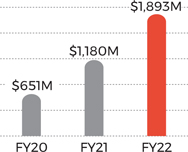
























 See page 40.
See page 40.































































 OUR FISCAL 2022 COMMITMENTS
OUR FISCAL 2022 COMMITMENTS


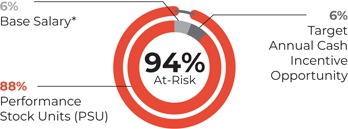

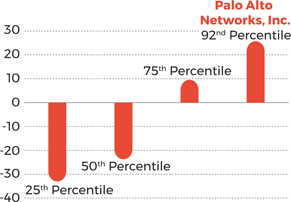
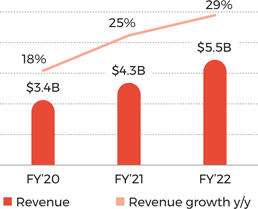


 1,482,000
1,482,000

